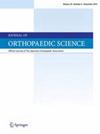Impact of multi-rod reinforcement on rod fractures in adult spinal deformity: A retrospective case series with a minimum follow up of 5 years
IF 1.5
4区 医学
Q3 ORTHOPEDICS
引用次数: 0
Abstract
Background
This study aimed to determine the impact of the multi-rod construct on rod fractures over a minimum follow-up period of five years in comparison to that with the conventional two-rod construct using the same technique, rod composition, and rod reinforcement method.
Methods
Data were retrospectively retrieved from a prospectively collected, single-center database. Consecutive patients >50 years of age who underwent thoracopelvic corrective fusion with planned two-stage anterior-posterior surgery and were followed up for at least five years were included in this study. The incidence of rod fracture in the conventional two-rod and multi-rod groups was investigated.
Results
A total of 58 patients (mean age, 68.9 years) were included in this study (follow-up rate, 73.4 %). Rod fracture was identified in 25 patients (43.1 %), within an average period of 25.1 months. The incidence of rod fracture in the multi-rod group was significantly lower than that in the two-rod group. However, there was no significant difference in the time to rod fracture between the two groups. Reinforcement of the multi-rod to the distal portion of the connector of the iliac screw had the lowest fracture rate and no cases of reoperation.
Conclusions
The incidence of rod fracture was significantly lower using multi-rod reinforcement, but the timing of rod fracture did not differ, compared to that with the two-rod construct using the same surgical technique and rod material. Multi-rod reinforcement covering the distal portion of the iliac screw is recommended to reduce the risk of fracture and reoperation.
多棒加固对成人脊柱畸形中棒骨折的影响:至少随访 5 年的回顾性病例系列。
背景:本研究旨在确定在至少五年的随访期内,多连杆结构对连杆骨折的影响,并与使用相同技术、连杆成分和连杆加固方法的传统双连杆结构进行比较:方法:从前瞻性收集的单中心数据库中回顾性检索数据。本研究纳入了年龄大于 50 岁、接受胸椎骨盆矫正融合术并计划进行两阶段前后手术且随访至少五年的连续患者。研究调查了传统双杆组和多杆组的杆骨折发生率:本研究共纳入 58 名患者(平均年龄 68.9 岁)(随访率 73.4%)。25名患者(43.1%)在平均25.1个月的时间内发现了连杆骨折。多连杆组的连杆骨折发生率明显低于双连杆组。不过,两组患者发生杆折断的时间并无明显差异。在髂骨螺钉接头远端加固多连杆的骨折率最低,而且没有再次手术的病例:结论:与使用相同手术技术和杆材料的双杆结构相比,使用多杆加固法的杆骨折发生率明显较低,但杆骨折发生的时间并无差异。建议对髂骨螺钉远端进行多杆加固,以降低骨折和再次手术的风险。
本文章由计算机程序翻译,如有差异,请以英文原文为准。
求助全文
约1分钟内获得全文
求助全文
来源期刊

Journal of Orthopaedic Science
医学-整形外科
CiteScore
3.00
自引率
0.00%
发文量
290
审稿时长
90 days
期刊介绍:
The Journal of Orthopaedic Science is the official peer-reviewed journal of the Japanese Orthopaedic Association. The journal publishes the latest researches and topical debates in all fields of clinical and experimental orthopaedics, including musculoskeletal medicine, sports medicine, locomotive syndrome, trauma, paediatrics, oncology and biomaterials, as well as basic researches.
 求助内容:
求助内容: 应助结果提醒方式:
应助结果提醒方式:


